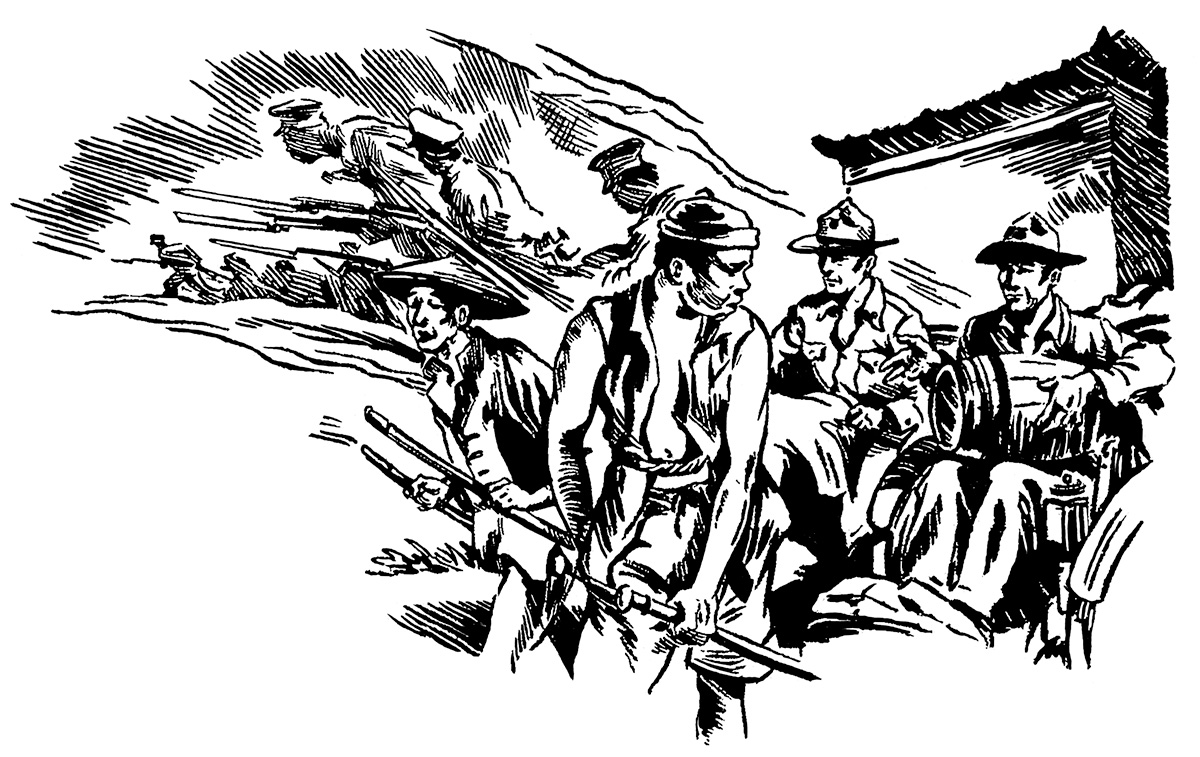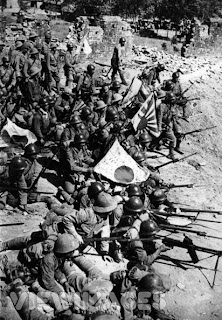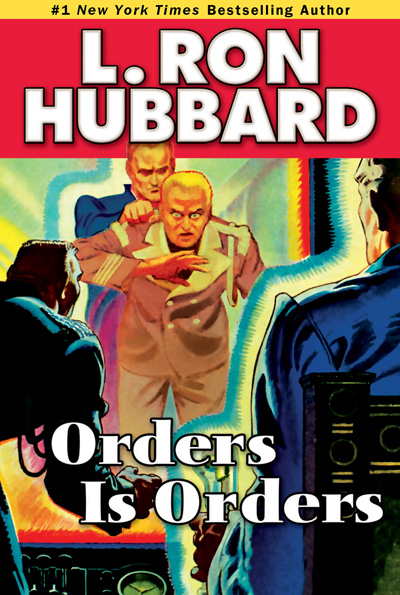Little Known Facts on Editorial Defiance and the Second Sino–Japanese War in Orders Is Orders
In the pantheon of early 20th-century literature, L. Ron Hubbard is celebrated for prolific contributions to the pulp fiction genre. His novella Orders Is Orders stands out for its vivid narrative and its defiance against the era’s literary conventions. Initially published in 1937 and set against the brutal backdrop of the Second Sino–Japanese War, Ron’s story challenged pulp fiction norms with an innovative structure and character development. The novella not only encapsulates the tensions of a significant historical conflict but also heralds a shift in how such conflicts are portrayed in literature, rebelling against editorial norms and reader expectations.
Synopsis of Orders Is Orders
Orders Is Orders unfolds in the heart of war-torn China amidst the chaos of the Second Sino–Japanese War. The story centers on Marine Gunnery Sergeant James Mitchell and Private First Class Spivits, deployed from the USS Miami and tasked with an almost impossible mission: to deliver a life-saving anti-cholera serum to a remote American consulate in Shunkien, China.

Marine Gunnery Sergeant James Mitchell and Private First Class Spivits—an illustration from the original 1937 pulp magazine
Along the dangerous 200-mile trek, they encounter Goldy, a fan dancer with a sharp tongue and a hidden depth, and Mitchell’s father, a stoic missionary whose life’s work is threatened by the encroaching conflict.

Goldy—an illustration from the original 1937 pulp magazine
Inspiration and Background
Before becoming a prolific and renowned writer, L. Ron Hubbard served as a First Sergeant in the US Marine Corps, gaining unique insights into military life and leadership. These experiences were crucial in shaping the themes of many of his works, including Orders Is Orders. His time in Asia coincided with escalating geopolitical tensions that later erupted into the Second Sino–Japanese War. This conflict, marked by its brutal scale and complex international interests, forms the dramatic backdrop of the novella. The war, characterized by numerous atrocities and strategic battles, profoundly influenced his portrayal of conflict, survival, and heroism.

The Second Sino–Japanese War
Historical Context of the Second Sino–Japanese War
The Second Sino–Japanese War lasted from 1937 to 1945 and was the largest Asian war in the 20th century, with over 25 million casualties. Orders Is Orders unfolds during the tumultuous period of this war, providing readers with a fictional yet poignant look into the era’s complexities. The novella’s setting in war-torn Shunkien, China, reflects the severe realities faced by those caught in the conflict, from the bombing of cities to the desperate struggles of civilians and soldiers alike. The Japanese troops in China were notorious for their brutal treatment of civilians. This war ended in August 1945 after the United States detonated nuclear weapons over Hiroshima and Nagasaki, and Russian troops invaded from the north and suppressed Japanese forces in Manchuria.
China emerged from the war politically unsettled, economically exhausted, and scarred by an enormous amount of human suffering, setting the stage for a civil war between the Nationalists and the Chinese Communists. Ron Hubbard’s narrative in Orders Is Orders does more than tell a story of military resilience; it offers a window into the impact of international warfare on individual lives and the small acts of courage that often go unnoticed.

China emerged from the war scarred by an enormous amount of human suffering
Revolution in Characterization, Plot, and Editorial Defiance
L. Ron Hubbard’s correspondence with fellow writer Russell Hays reveals a deliberate departure from traditional storytelling in Orders Is Orders. Russell discusses what he terms the literary “lift” or emotional plotting. In contrast, Ron advocates instead for a realism drawn from his personal experiences, which manifested most notably in his characters.
Rebelling against the “main track” of conventional heroes and lovely heroines typically favored by editors of the day, Ron described his revolt in a letter to Russell: “I had a somewhat ordinary plot to begin and suddenly in a flash of revolt I tossed out my lovely heroine and made her a fan dancer out of anger for all lovely and impossible heroines. I threw away my dashing lieutenant and substituted a drunken top sergeant. I snatched up a Chinese missionary and wrote him as I knew him. I back-slapped the Japanese for stopping me and almost jailing me once in Tsingtao.”
This “flash of revolt” was not merely a stylistic choice but a pointed critique of the restrictions pulp fiction editors put on authors’ freedom to create. Ron’s frustration with editorial mandates is palpable in these exchanges, highlighting his commitment to authenticity over market expectations. It is also palpable in his amusing notes on the subject, “How to Drive a Writer Crazy.”
Critical Acclaim and Legacy
Upon the republication of the story in 2009, Orders Is Orders received a starred review from Publishers Weekly, stating, “Demonstrating his unique ability to relate even to the most complicated story with a keen eye for detail and realism, Hubbard’s stunning writing ability and creative imagination set him apart as one of the greatest literary figures of the 20th century.”
A Cinematic High-Definition Audio Experience
AudioFile Magazine and Midwest Book Review also lauded the story’s compelling dialogue and atmospheric settings, brought to life through a full-cast audio production that includes sound effects and period music, enhancing the immersive experience of the story. Experience this 3D audio landscape firsthand with the following excerpt:
Conclusion
 Orders Is Orders has endured and thrived in the modern era, capturing the imaginations of new generations of readers and listeners. It is a seminal piece in L. Ron Hubbard’s oeuvre, exemplifying his unique approach to storytelling. This novella defied the pulp fiction norms of its time and offered a nuanced look at the human elements of warfare and survival. Ron’s legacy, as seen in Orders Is Orders, is characterized by a fearless commitment to storytelling that honors truth over convention.
Orders Is Orders has endured and thrived in the modern era, capturing the imaginations of new generations of readers and listeners. It is a seminal piece in L. Ron Hubbard’s oeuvre, exemplifying his unique approach to storytelling. This novella defied the pulp fiction norms of its time and offered a nuanced look at the human elements of warfare and survival. Ron’s legacy, as seen in Orders Is Orders, is characterized by a fearless commitment to storytelling that honors truth over convention.
To order a copy of Orders is Orders, click here.
Other articles and resources you may be interested in:
Little Known Facts from All Frontiers Are Jealous
Little Known Facts from Branded Outlaw
Little Known Facts from The Battling Pilot
Little Known Facts from Inky Odds
Little Known Facts from Man-Killers of the Air
Little Known Facts from Mister Tidwell, Gunner
Little Known Facts from Tomb of the Ten Thousand Dead
The Little-Known Facts of Newsreels from Trouble on His Wings
Leave a Reply
Want to join the discussion?Feel free to contribute!




I would like to say this is one of my favorite stories by Ron. Being a Marine myself, I feel Ron captured exactly how Marines have always reacted to impossible orders that need to be carried out. Adapt and overcome whatever obstacle you have to get the job done. It’s a masterpiece!!